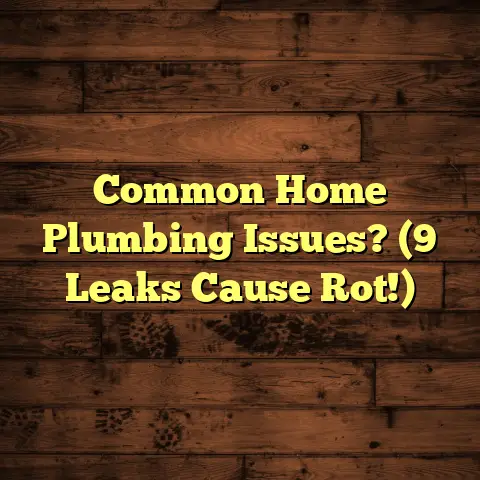Clean Floors With Vinegar? (3 Pro Secrets!)
Are you still spending a fortune on expensive floor cleaners that promise a sparkling shine but leave your wallet empty and your floors dull? I see it all the time!
What if I told you that the secret to pristine floors lies in a humble kitchen staple? Yes, we’re talking about vinegar!
But before you rush to the pantry, let’s uncover the three pro secrets that will transform your cleaning routine and bring your floors back to life.
Section 1: The Science Behind Vinegar as a Cleaning Agent
1.1 Understanding Vinegar
Okay, let’s get down to brass tacks. Vinegar, at its core, is simply acetic acid diluted with water. The stuff you buy at the grocery store usually has about 5% acetic acid.
It’s this acidity that makes it such a surprisingly effective cleaning agent. Think of it as a gentle acid that breaks down dirt, grime, and even mineral deposits.
It works by reacting with alkaline substances (like soap scum or hard water stains), neutralizing them and making them easier to wipe away. It’s chemistry in action, folks!
1.2 Comparison to Commercial Cleaners
Now, I know what you’re thinking: “Vinegar versus those fancy commercial cleaners? Is that even a fair fight?”
Well, let’s break it down. Commercial cleaners are often packed with harsh chemicals, artificial fragrances, and sometimes even toxins.
Vinegar, on the other hand, is natural, biodegradable, and readily available.
Cost-Effectiveness:
Vinegar is significantly cheaper. You can get a gallon of cleaning vinegar for just a few dollars, whereas specialized floor cleaners can cost upwards of $10-$20 a bottle.
Safety:
Commercial cleaners often require gloves and ventilation due to their strong chemicals. Vinegar is much safer to handle, especially if you have kids or pets.
Environmental Impact:
The chemicals in many commercial cleaners can harm aquatic life when they go down the drain. Vinegar is environmentally friendly and breaks down quickly.
But, let’s be real, there are downsides. Vinegar has a distinct smell that some people find unpleasant. Also, it may not be as effective on certain types of stubborn stains as some specialized cleaners.
However, for everyday cleaning, I find that vinegar holds its own surprisingly well. In fact, a study published in the “Journal of Environmental Health” found that vinegar was effective in killing common household germs like E. coli and Salmonella. [Journal of Environmental Health] (https://www.neha.org/node/59533)
1.3 Health Benefits
This is a big one for me, especially now that I have little ones running around. Using non-toxic cleaning alternatives like vinegar significantly reduces the risk of exposure to harmful chemicals.
Kids and pets are particularly vulnerable because they spend more time on the floor and tend to put things in their mouths.
By switching to vinegar, you’re creating a healthier home environment, reducing the risk of allergies, respiratory problems, and other health issues associated with chemical exposure.
Plus, think about it, those artificial fragrances in commercial cleaners? They can trigger headaches, asthma, and other sensitivities in some people. Vinegar, especially when combined with essential oils, offers a much gentler and more natural aromatic experience.
Section 2: Pro Secret #1 – The Perfect Vinegar Solution for Different Flooring Types
Alright, now for the real secrets! Not all floors are created equal, and you can’t just slosh vinegar on everything and hope for the best.
Here’s how to tailor your vinegar solution to different flooring types:
2.1 Hardwood Floors
This is where you need to tread carefully. Hardwood floors are beautiful, but they can be sensitive to moisture and acidity.
The Ideal Ratio:
The key is to use a very diluted solution. I recommend a ratio of 1/2 cup of white vinegar to 1 gallon of warm water.
Too much vinegar can strip the finish or even damage the wood over time.
Application Tips:
- Damp Mop, Don’t Soak: Wring out your mop thoroughly so it’s just damp, not dripping wet.
- Work in Sections: Clean small areas at a time, and dry them immediately with a clean, dry cloth. This prevents water from seeping into the seams.
- Avoid Waxed Floors: Vinegar can dull waxed hardwood floors. If you have waxed floors, stick to a cleaner specifically designed for them.
I also recommend testing the solution in an inconspicuous area first to make sure it doesn’t damage the finish. Better safe than sorry!
2.2 Tile and Grout
Tile floors are much more forgiving than hardwood, but grout can be a real pain to clean. Vinegar is your friend here!
Tile Cleaning Recipe:
- 1 cup of white vinegar
- 1 gallon of warm water
For heavily soiled tile, you can increase the vinegar concentration slightly, but don’t go overboard.
Grout Cleaning Power:
For grout, I like to make a paste of:
- 1/2 cup of baking soda
- 1/4 cup of white vinegar
Apply the paste to the grout lines, let it fizz for a few minutes, then scrub with a stiff brush. Rinse with water and wipe dry.
Precautions:
- Test on Colored Grout: Vinegar can sometimes discolor colored grout. Test in an inconspicuous area first.
- Avoid Natural Stone: Don’t use vinegar on natural stone tiles like marble or granite. The acidity can etch the surface.
2.3 Laminate and Vinyl
Laminate and vinyl floors are relatively easy to clean and can handle vinegar well, as long as you’re careful.
Safe Vinegar Solution:
- 1/4 cup of white vinegar
- 1 gallon of warm water
Again, dilution is key. You don’t want to leave a vinegar residue on these floors.
Application Methods:
- Microfiber Mop: Use a microfiber mop for best results. Microfiber is gentle and effective at picking up dirt and grime.
- Spray Bottle: You can also use a spray bottle to apply the solution, but be sure to wipe it up immediately.
Important Note:
- Avoid Soaking: Never soak laminate or vinyl floors with water. This can cause them to warp or peel.
Section 3: Pro Secret #2 – Enhancing Vinegar’s Cleaning Power
Vinegar is great on its own, but you can supercharge its cleaning power with a few clever additions.
3.1 Essential Oils
Adding essential oils to your vinegar cleaning solution not only makes your house smell amazing, but also provides extra antibacterial and antiviral benefits.
Popular Essential Oils and Their Benefits:
- Lemon: Bright, citrusy scent; antibacterial and degreasing properties.
- Tea Tree: Strong antiseptic and antifungal properties.
- Lavender: Calming scent; antibacterial and antiviral properties.
- Eucalyptus: Refreshing scent; antiseptic and decongestant properties.
How to Use:
Add 10-20 drops of your favorite essential oil to your vinegar cleaning solution. Shake well before each use.
My Personal Favorite:
I love using a combination of lemon and tea tree oil for a fresh, clean scent and extra germ-fighting power.
3.2 Baking Soda Boost
Vinegar and baking soda are a dynamic duo when it comes to tackling tough stains and odors.
How It Works:
When you mix vinegar and baking soda, they react to create carbon dioxide, which helps to lift dirt and grime.
Step-by-Step Guide:
- Sprinkle Baking Soda: Sprinkle baking soda directly onto the stain or odor.
- Pour Vinegar: Pour a small amount of vinegar onto the baking soda.
- Let It Fizz: Let the mixture fizz for a few minutes.
- Scrub: Scrub with a brush or sponge.
- Rinse: Rinse with water and wipe dry.
Caution:
- Don’t Use in a Closed Container: The reaction between vinegar and baking soda can create pressure, so never mix them in a closed container.
3.3 Natural Additives
Besides essential oils and baking soda, there are other natural additives that can enhance the cleaning power of vinegar.
- Lemon Juice: Adds extra degreasing power and a fresh scent.
- Castile Soap: A gentle, all-natural soap that can help to remove stubborn dirt and grime.
- Borax: A natural mineral that can help to boost the cleaning power of vinegar and remove stains. (Use with caution and keep away from children and pets.)
Experiment and Find What Works Best for You:
Every home and every floor is different, so don’t be afraid to experiment with different combinations of natural additives to find what works best for your specific needs.
Section 4: Pro Secret #3 – The Best Techniques for Cleaning Floors with Vinegar
Okay, you’ve got your vinegar solution prepped and ready to go. Now, let’s talk technique!
4.1 Mopping Techniques
The way you mop your floors can make a big difference in the final result.
Tools Needed:
- Microfiber Mop: As I mentioned before, microfiber mops are ideal for cleaning floors with vinegar. They’re gentle, effective, and easy to clean.
- Two Buckets: One for your vinegar solution and one for rinsing your mop.
- Clean, Dry Cloths: For drying any excess moisture.
Technique:
- Sweep or Vacuum: Always start by sweeping or vacuuming your floors to remove any loose dirt or debris.
- Dip and Wring: Dip your mop into the vinegar solution, and wring it out thoroughly. You want it to be damp, not dripping wet.
- Mop in Sections: Work in small sections, overlapping each stroke slightly.
- Figure-Eight Motions: Use figure-eight motions to ensure that you’re covering the entire surface.
- Rinse Often: Rinse your mop frequently in the clean water bucket to remove any dirt or grime.
- Dry Immediately: Use a clean, dry cloth to dry any excess moisture.
4.2 Stain Removal Methods
Vinegar can be surprisingly effective at removing a variety of stains.
Common Stains and How to Tackle Them:
- Pet Urine: Soak up as much urine as possible with a clean cloth. Then, pour a solution of equal parts vinegar and water onto the stain. Let it sit for 10-15 minutes, then blot with a clean cloth.
- Food Spills: Wipe up the spill immediately. Then, clean the area with a solution of vinegar and water.
- Hard Water Stains: Spray the stain with undiluted white vinegar. Let it sit for a few minutes, then scrub with a brush or sponge.
- Grease: Mix vinegar with a small amount of dish soap. Apply to the grease stain, let it sit for a few minutes, then scrub and rinse.
Important Tip:
- Let It Sit: For stubborn stains, let the vinegar solution sit for longer to allow it to break down the stain.
4.3 Regular Maintenance
The key to keeping your floors clean and sparkling is to establish a regular maintenance routine.
Suggested Routine:
- Daily: Sweep or vacuum your floors to remove any loose dirt or debris.
- Weekly: Mop your floors with a vinegar solution.
- Monthly: Deep clean your grout with a baking soda and vinegar paste.
Consistency Is Key:
The more consistently you clean your floors, the less dirt and grime will build up, and the easier it will be to keep them looking their best.
Conclusion: The Transformation of Your Floors with Vinegar
So, there you have it – the three pro secrets to cleaning floors with vinegar!
I hope I’ve convinced you to ditch those expensive commercial cleaners and give vinegar a try. It’s a natural, affordable, and effective way to keep your floors clean and your home healthy.
Experiment with different ratios, essential oils, and techniques to find what works best for your specific flooring type and cleaning needs.
And don’t be afraid to share your experiences and any additional tips you have on cleaning floors with vinegar in the comments below! I’m always learning and love hearing from you.
Now go forth and transform your floors with the power of vinegar! You might just be surprised at the results.





